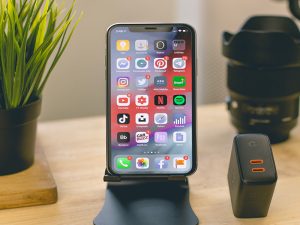 Scrolling through TikTok offers a welcome escape during the pandemic, something more adolescents than ever have been doing to stay connected with friends.
Scrolling through TikTok offers a welcome escape during the pandemic, something more adolescents than ever have been doing to stay connected with friends.
But the video content the social platform serves its users is not always harmless entertainment. Many adolescents are seeing videos that promote eating disorders, and the impact on their mental health can be devastating.
Videos Promoting Eating Disorders
TikTok is most popular among adolescents ages 10-19, who use the short-video app to create their own videos, connect with friends, and watch user-generated content.
Over the last year, more adolescents have turned to social media sites like TikTok to manage the stress and loneliness caused by the pandemic. In fact, researchers at Ann and Robert H. Lurie Children’s Hospital of Chicago surveyed 2,000 parents and found that 63% of the respondents believed that their teens were using social media more often because of the pandemic.
But in addition to videos of trending dances and lip syncs, TikTok has been serving many adolescents content that promotes eating disorders.
These videos depict harmful eating and exercise behaviors, or they show users who have slimmed their waistlines, added muscle tone, or changed their facial structures using body-editing apps.
Some users try to counteract these harmful videos by posting content that discusses their eating disorder recovery journeys. But experts say that these recovery stories can sometimes do more damage than good because before and after images can be triggering, or a person may not talk about recovery in the most accurate light.
Working Against the Algorithm
TikTok has made efforts to restrict content that may be harmful to its users. The platform’s community guidelines ban videos that promote behaviors that could lead to the development of an eating disorder.
And in February 2021, TikTok added a new feature that connects users with support and resources if they search for the hashtags #edrecovery, #proana, or other eating disorder-related phrases.
But these efforts haven’t stopped harmful content from reaching vulnerable adolescents, who only need to watch a video once for similar content to start showing up in their For You page.
TikTok’s algorithm recommends videos based on various factors, including the way a person interacts on the platform; the hashtags, sounds, or captions they use; and personal settings like their country or device type.
Users can control the content they see by tapping “Not Interested” or hiding content from certain creators. But this places a heavy responsibility on adolescents, who often don’t understand the impact of the media they are consuming.
How Parents Can Help
Parents can play a powerful role in the way adolescents use social media. Here are some tips for how parents can promote healthier social media consumption:
- Talk to your child about setting limits – Help your child understand why it’s important to set healthy limits on their social media use.
- Limit social media use – If your child is struggling with how much they are using social media, set limits on how long they can access their social media accounts each day. TikTok has a parental control setting that allows you to set time limits directly in the app.
- Openly discuss body image and eating behaviors – Talking to your child about the types of bodies and eating behaviors they are seeing on social media can help them form a healthier relationship with food and their body.
- Give them opportunities to disconnect – Offline interactions without filters and editing can remind your child how beautiful real life can be.
The content your child is viewing on TikTok can put them at risk for lower self-esteem and body image concerns. And for those who are already struggling with an eating disorder, the consequences can be even more damaging.
But creating a safe space for your child to discuss these feelings with you can help them learn to use social media in a healthier way.
